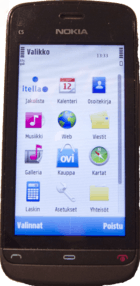Nokia C5-03
The Nokia C5-03 is a budget resistive touchscreen smartphone with WLAN from the Cseries that was released in December 2010.[4] The phone has Shazam music identification software and social networking software included or available for download.
 | |
| Manufacturer | Nokia |
|---|---|
| Compatible networks | GSM, EGPRS, WCDMA, HSDPA, A-GPS |
| Predecessor | Nokia 5230 Nokia 5233 Nokia 5250 |
| Successor | Nokia 500 Nokia Asha 311 |
| Related | Nokia 5800, Nokia C6-01 |
| Form factor | Candybar |
| Dimensions | 105.8 x 51 x 13.8 mm |
| Mass | 93g |
| Operating system | Symbian OS 9.4 + S60 platform 5th Edition (s60v5) (the newer Symbian3 OS was already available when the mobile was announced in October 2010)[1] |
| CPU | ARM11 @ 600 Mhz[2] |
| Memory | 40 MB User Storage, 128 MB SDRAM, 256 MB NAND |
| Removable storage | max. 16 GB microSDHC (32 GB unofficial), 8 GB card included |
| Battery | BL-4U (3.7V 1000mAh); 2 mm charging connector |
| Data inputs | Touchscreen with Nokia Dynamic Intelligent Layouts, accelerometer |
| Display | nHD 640 x 360 pixels,[3] 3.2 inch 16:9 widescreen, (16.7 million colours) transmissive LCD technology[2] |
| Rear camera | 5.0 Megapixels, Video resolution: 640x352, 15fps |
| Front camera | No dual camera |
| Media | AAC, AAC+, eAAC+, MP3, MP4 (MPEG-4 Part 2 VGA / H.264 QVGA), M4A, WMA, AMR-NB, AMR-WB, Mobile XMF, SP-MIDI, MIDI Tones (poly 64), RealAudio 7,8,10, True tones, WAV, but not Ogg files. |
| Connectivity | Bluetooth 2.0 (EDR/A2DP), WLAN (802.11 b/g), MicroUSB 2.0; 3.5 mm headphone and video-out jack |
It has Assisted GPS, and Ovi Maps 3.0 integrated.[4]
Hardware
| CPU | 600 MHz ARM11 processor (ARM v6 architecture) |
|---|---|
| Storage | 40 MB storage, 128 MB RAM |
| Developer Platform | S60 5th Edition |
|---|---|
| Operating System | Symbian OS v9.4 |
| Screen Resolution | 360 x 640 pixels |
| Development Frameworks | Qt,[1] Web Runtime, Java, Symbian C++, Flash, Open C/C++ |
| Screen Resolution | 360 x 640 pixels |
| Screen Color Depth | 24 bits |
| Screen Size | 3.2 inches |
| Display Technology | LCD transmissive |
| Device Size | 105.8 x 51 x 13.8 mm |
| Volume | 65 cc |
| Weight | 93 g |
| Display Touch Technology | Resistive Single-Touch |
| Input Method | Touch Screen |
| Other Keys | Call Creation Key, Call Termination Key, Lock Switch, Menu Key, Volume Keys |
| Frequency Bands | GSM 1800, GSM 1900, GSM 850, GSM 900, WCDMA Band I (2100), WCDMA Band II (1900), WCDMA Band VIII (900) |
| Data Bearers | Dual Transfer Mode (MSC 32), EDGE Class B, GPRS, HSDPA Cat9 10.2 Mbit/s, HSUPA Cat5 2.0 Mbit/s, WLAN IEEE 802.11 b/g |
| Regional Availability | Brazil, China, Eurasia, Europe, India, Latin America, Middle East, North America, SEAP |
| CPU Count | Single CPU |
| CPU Type | ARM 11 |
| CPU Clock Rate | 600 MHz |
| Notes | 1 Qt content can be published to Ovi Store. |
| Extra Features | Accelerometer sensor, Flight Mode, Firmware over the Air (FOTA), Nokia Maps 3.0, Nokia Music, Nokia Store, Ovi Contacts, software updates, themes |
| Positioning | A-GPS, GPS |
gollark: This is hilarious: https://twitter.com/lrvick/status/1320293667429560321
gollark: However, you are probably not blocked.
gollark: osmarks.tk goes down sometimes, see, for apioformic reasons.
gollark: I use Qubes OS in a VM in Kali in Haiku OS for that secure security.
gollark: Yes. The Arch install is efficient and practical.
References
- "mobile articles on Engadget". Engadget.
- "Archived copy". Archived from the original on 18 October 2010. Retrieved 16 October 2010.CS1 maint: archived copy as title (link)
- "QHD" – via The Free Dictionary.
- "The latest Nokia phones and accessories - Nokia Phones US". europe.nokia.com.
This article is issued from Wikipedia. The text is licensed under Creative Commons - Attribution - Sharealike. Additional terms may apply for the media files.